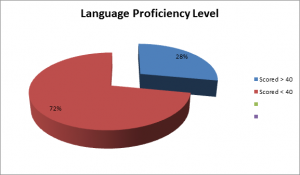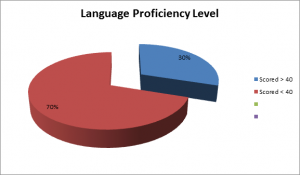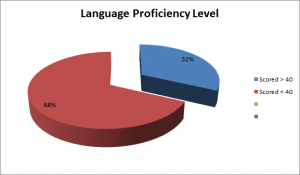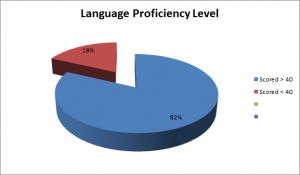ELTWeekly Vol. 4 Issue#30 | July 23, 2012 | ISSN 0975-3036
This paper has been submitted for publication by Vairamuthu Suntharesan, Senior Lecturer,ELTC, University of Jaffna, Jaffna, Sri Lanka.
Abstract
Using the student’s mother tongue in the ESL classes has been felt to be very productive as it is found to develop language accuracy and fluency. The objective of this paper is to discuss how mother tongue can be effectively used in teaching certain linguistic areas in order to motivate students and promote their language proficiency faster. Translation in ESL classes which enables the process of comparing student’s first language with the second language would undoubtedly enable students to attain the ability of using the language in real life situations for communicative purposes.
The beneficial role of mother tongue in second language learning is studied in this paper with the help of authentic data elicited from an experiment carried out among learners. From the Faculty of Arts, University of Jaffna, 50 undergraduates reading in the 3rd year were selected at random and divided into two groups i.e. the Control Group and the Experimental Group. An identical Pre – Test was conducted among both groups and the results were found to be with very little variation. Language skills were imparted with the use of Tamil, the students’ mother tongue to the Experimental Group. Classes for the Control Group were conducted purely in English to teach the language skills. The duration of course lessons for each group was six months. At the end of this course duration, the students were required to sit Post – Tests. Their performances in the tests showed that the Experimental Group fared much better than the Control Group. The findings stressed the benefit of using mother tongue in the ESL classes.
Introduction
The Communicative Language Teaching which is currently in vogue emphasizes the greater use of English in teaching English as a Second Language. Yet, one should be alerted of the fact that neglecting the students’ mother tongue may lead to adverse effects. It should be borne in mind that greater the use of mother tongue, higher the extent of cognitive thinking, sense of security and confidence among learners. Using the mother tongue as a resource for the promotion of language learning has gained currency recently as translation seems to promote the three qualities considered to be essential for language learning : accuracy, clarity and flexibility (Ross, 2000 as quoted in Kalvaliauskiene, 2009).
In the past, the adoption of Grammar Translation Method resulted in unsatisfactory results. This method failed to develop speech ability among students. Subsequently it was proposed to avoid the use of mother tongue in the ESL classroom and translation was felt to be unproductive and uninteresting.
Nowadays there is focus on translation as there is an awareness of the inevitable use of mother tongue as a resource to promote language proficiency. The use of mother tongue and translation which are concomitant in the process of teaching are expected to develop language skills. This paper attempts to demonstrate how language areas can be effectively taught through translation that eliminates monotony, boredom and a feeling of hatred and creates enthusiasm among students.
Literature Review
In this section, views expressed by various scholars in relation to the theme of this article have been discussed.
According to Auerbach (1993:13) , “ The international dominance of English native speakers who find absolution in the dogma of monolingualism when they can not understand the language of their pupils, together with the cheaper mass production of strictly English-speaking in the Anglo-American mother country, constitutes one of the reasons behind the sanctification of, and the demand for, monolingualism in the classroom.”
Butzkamm (2003: 5) remarked , “ Using the mother tongue, we have learnt to think, learnt to communicate and acquired an intuitive understanding of grammar. The mother tongue opens the door, not only to its own grammar, but to all grammars in as much as awakens the potential for universal grammar that lies within all of us. The mother tongue is the master key to foreign languages, the tool which gives us the fastest, surest, most precise, and most complete means of accessing a foreign language.”
Bhushan (2010: 211) commented, “ Some purposes of L1 use might be: for explaining difficult grammar, for giving instructions which might not be understood in English, for checking comprehension and for saving time which can then be used for communicative work in English etc.”
Carless (2008) explained that mother tongue may serve social and cognitive functions. He argued that students working in groups do not have to speak English all the time and use of mother tongue relates to learner identity. As the use of mother tongue provides learners with a sense of security, they learn with much ease and comfort.”
Hammerly (1991:151) stated that the appropriate use of mother tongue in L2 learning “can be twice as efficient without any loss in effectiveness, as instruction that ignores the students’ native language.”
Harmer (2001:131) viewed, “A principal cause of the L1 use is required by the activity, if students are linguistically incapable of activating vocabulary for a chosen task. Another reason is that translation is a natural thing to do in language learning and code-switching between languages as regarded as naturally developmental.”
The use of mother tongue provides students with comfort in reading difficult texts in the L2. Although we have masterpieces like Dicken’s “Great Expectations” or “Oliver Twist” or Emma’s “Pride and Prejudice”, higher proficiency in L2 is required to read and enjoy such novels. In such instances, the author suggests that students should be allowed to read the available Tamil versions of these novels before reading the English versions. Once the students have acquired a clear perception of the theme of the novel in Tamil, their motivation will rise remarkably to read the same in English. Intrinsically they will attempt to correspond a good number of Tamil words with their equivalents in English and thus they develop their vocabulary. Juxtaposition of syntactic structures of both languages, in the minds of students would doubtlessly shed light on the main grammatical features of the L2.
Students may feel frustrated and tend to believe that their identity is jeopardized if their mother tongue is made degenerate. It is only through the mother tongue that advanced concepts can be interpreted. The use of bilingual dictionaries, seeking teacher’s explanations etc. by students are evidences for the inevitable use of mother tongue in the L2 class. It should be borne in mind that language and culture are always interwoven and if the students’ culture is neglected, it will result in the risk of damaging the students’ identity.
Furthermore, translation is treated as the fifth skill together with the other four skills of listening, speaking, reading and writing. There may be some students who are able to read and understand authentic reading and listening materials but most of them are found to mentally translate the texts.
The Method
Fifty undergraduates in the 3rd year of the Faculty of Arts of the University of Jaffna were selected for the study. They were divided into two target groups of students. Group- A is considered as a Control group and Group- B, Experimental group.
Medium of Instruction
Same syllabus was utilized for teaching English language skills to both groups. For Group- A, instructions on language skills were imparted purely in English. Group- B was taught with the use of Tamil, the mother tongue of the students.
Procedure
A pre-test was conducted among the two groups to assess the language skills that were to be taught to them. These groups were imparted instruction for a complete semester. The control group was given instructions in language skills without the use of Tamil. The experimental group was taught to promote their language skills with the use of Tamil. After the end of the programme, these groups were given post-tests.
Results and Data Analysis
The students’ performances in the tests administered to the two groups represent the outcome of the current research.
The pre-test result of the control group is represented by Chart-A and that of the experimental group is demonstrated in Chart-B.
The results of the pre-tests reveal that the levels of the basic language skills of the groups remain almost the same, with very little variation that can be ignored.
Chart – A
Chart – B
The post-test result of the control group is shown in Chart-C and that of the experimental group in Chart-D.
It is evident from the results that the language proficiency level of the students of the experimental group has risen dramatically. An informal discussion with the students by the author confirms the fact that students feel more comfortable, cheerful and secure in a bilingual class than in a monolingual class. Subsequently they perform remarkably well in their studies. Their ability to comprehend the lessons is supported positively by the use of their mother tongue. Whereas the performance level of the students of the control group almost remains the same, with no progress. They openly stated that they encounter severe impediments in understanding the lessons in many instances because of the teacher’s failure in using Tamil to understand portions which inevitably require the students’ mother tongue. They find the class monotonous, boring and difficult to follow.
Chart – C
Chart – D
Teaching areas essentially requiring the use of mother tongue
In this section, the author demonstrates how Tamil can be used in teaching ESL to students whose mother tongue is Tamil, for better results.
Conjunctions
The use of Tamil seems to be a must in teaching conjunctions. Explaining the meaning of ‘If’ or ‘Although’ merely in English would only make the students have a blank face. When Tamil equivalents of these conjunctions are made available to the students, they find no difficulty in using them in the correct way. For example, two related sentences in English may be written on the blackboard and the students may be asked to link the two sentences using a suitable conjunction. As an aid, the teacher could ask the students to translate the two English sentences into Tamil and find a linking word in Tamil to combine the sentences. The next step of the teacher can probably be to provide the English equivalent of the Tamil linking word. The students having thought it in the Tamil context will be able to approach the English sentences with much ease and comfort.
Pronouns
Though the personal pronouns can be taught with demonstrations, the pronouns in the objective case and the possessive pronouns may require the use of Tamil, to be explained. In Tamil, the pronoun of the objective case has two forms, whereas in English, it has a single form as illustrated below.
English Tamil Form
eg.1) Me i) әnnai
ii) әnakku
eg.2) Him i) avanai
ii) avanukku
The use of Tamil will be helpful to show this difference in forms of the objective case pronouns between English and Tamil.
Likewise the explanation on the function of the possessive pronouns too should involve the use of Tamil so that the students will be able to differentiate the functions of the possessive adjective and the possessive pronoun.
e.g. i) It is her pen.
(Possessive Adjective)
ii) It is hers.
(Possessive Pronoun)
When the above two English sentences are translated into Tamil, the students will easily understand what is taught to them.
Adjectives
The Adjective of Quantity, Demonstrative Adjective, Adjective of Number etc. can be taught by demonstration with less involvement of verbal explanation. In case of the Adjective of Quality, the use of Tamil becomes inevitable to explain its function better. For example, adjectives such as proud, cruel, kind and witty can not be taught by demonstration , and in such cases, providing Tamil equivalents of these adjectives would do much good to the students. Besides, the degrees of adjectives found in the English grammar are not so significant in Tamil except the use of the words like ku:dutala:ha , miha, and miha athihalavil referring to the English ‘more’ or ‘most’. Therefore some extent of explanation in Tamil to compare the degrees of the English adjectives with that of Tamil will help the students for a clear understanding.
Adverbs
In the English grammar, there are certain adverbs that have the same form as adjectives. For example, words like Hard, Fast, Late and Early function as both adjectives and adverbs. Though the difference in the functions of adjectives and adverbs as modification of nouns and modification of verbs respectively could be pointed out to the students, the Tamil translation of the English sentences in which the adjectives and adverbs occur will be beneficial to them for faster understanding.
eg. i) He is a fast driver.
Tamil translation of the above sentence: “ avan oru viraiva:na ca:rathi ”
ii) He drives fast
Tamil translation of the above sentence: “ avan viraiva:ha va:hanam celuttuhinra:n”
By observing the difference in the inflectional endings in the adjective and the adverb underlined in the above Tamil translated sentences, and corresponding the Tamil forms of the adjective and the adverb to the respective English forms of the adjective and the adverb, students may easily comprehend the difference of meanings of the same word functioning both as an adjective and an adverb.
Defective Verbs
The use of mother tongue in teaching defective verbs has been found to be very effective. For example, rather than teaching the students that the function of the defective verb, ‘Must’ is to show a duty, a necessity or an obligation, providing the Tamil translation of an English sentence in which the word ‘Must’ occurs would be very effective among the students to pick up the meaning of the word ‘Must’.
eg.: We must obey our parents
When the Tamil translation of the above sentence is made available to students, they are able to link the sentence with the social context and catch up the function of the defective word very easily.
Tenses
The use of Tamil appears to be very compulsory in the teaching of certain English tenses such as the Present Simple, the Present Continuous, the Present Perfect Continuous, the Past Perfect, the Past Perfect Continuous and the Future Perfect.
For example, in Tamil the same form of sentence can represent the Present Simple Tense and the Present Continuous Tense.
eg. i) He drives slowly.
ii) He is driving slowly.
iii) avan metuva:ha va:hanam celuttuhinra:n
In the above set of sentences, the third sentence expressed in Tamil can be used to denote either the action of driving slowly usually or the action of driving slowly at the present moment. The explanation in Tamil is the only means to explain the difference in the specific situations in which the Present Simple and the Present Continuous tenses are used.
Likewise, the instruction on the difference in the situations where the Present Perfect and the Past Simple tenses are used will require the use of Tamil. Besides, the perfect tenses seem to be significant in form and function in English and since Tamil lacks such features, it will be natural for teachers to add sufficient information on the use of perfect tenses and to switch to Tamil to avoid confusion among students.
Vocabulary
When technical terms involve in a text, providing Tamil equivalents for them will stimulate the students’ interest. Providing Tamil equivalents is appreciable in the sense that it’s an instant technique of meaning production. Besides, the students may have already come across the Tamil equivalents in a similar text in Tamil and once they hear the Tamil equivalent from the teacher, they will be able to comprehend the given English text with ease. For example, students learning Geography as a subject may have already been familiar with the word, arippu in tamil, meaning ‘erosion’. The teacher who teaches a passage in which the term, ‘erosion’ occurs may produce the Tamil term, arippu himself or motivate the students to identify this Tamil term by offering some clues.
Conclusion
The use of mother tongue in second language learning has been a controversial issue for a long time. Most of the recent researches endorse that the use of mother tongue facilitates the learning process of second language. It has been pointed out that depending on the learners’ target language proficiency level, the extent of the mother tongue use in the classroom should be determined without affecting the learners’ opportunity for the exposure to the target language. Mother tongue is primarily used for translation and explanation in certain linguistic areas such as adjectives, tenses, vocabulary etc.
Further, mother tongue frees learners from psychological barriers like embarrassment, nervousness etc. and offers them mental comfort. It also creates a kind of rapport between the teacher and the learners and the learners are motivated to have interaction with the teacher independently. Mother tongue provides a new dimension to the class and makes it pupil friendly and lively.
References
Auerbach, E (1993). Reexamining English only in the ESL classroom. A teacher of English to speakers of other languages publication. TESOL Quarterly: 27 (1), 9-32
Bhushan, R (2010). Mother tongue. The neglected resource for English language teaching and learning. www.langugeinindia.com
Butzkamm,W (2003). We only learn language once. The role of mother tongue in foreign language classrooms: death of a dogma. Language Learning Journal, Winter 2003, No.28, 29-39
Carless,D (2008). Student use of the mother tongue in the Task-Based classroom. ELT Journal, 62 (4) 331-338
Hammer,J (2001). The practice of English language teaching. England: Pearson Education Ltd.
Hammerly, H (1991). Fluency and accuracy. Toward balance in language teaching and learning. Multilingual Matters, 73
Kalvaliauskiene, G (2009). Role of mother tongue in learning English for specific purposes. ESP World, Issue 1 (22), Vol.8, 2009.





1 comment